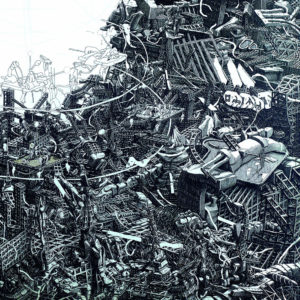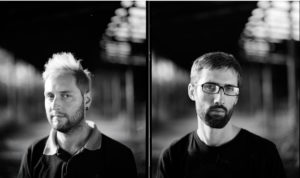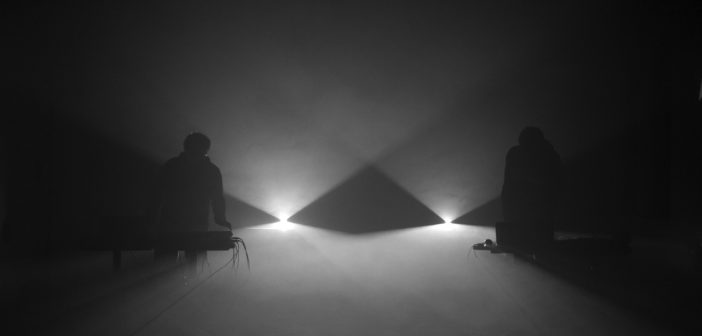Lumisokea are a Belgian-Italian duo based in Berlin. The first time I saw them was at MUTEK festival in Mexico City last year where they were shrouded in darkness, bar two white lights shining out into the audience. The sound of drums and drones shook me almost to tears I was so moved. Since then they have been touring a new record, Transmissions from Revarsavr, released on UK-based label Opal Tapes. Across emails and some months, we pieced together a discussion that covers their influences, compositional methods and performance practices. There’s even some politics thrown in. Check out their Bandcamp page and read on to find out more.
Compared to Mnemosyne, Transmissions from Revarsavr is saturated with percussive sound. You’ve still got moments of ambience and silence, but largely the record returns to your experiments in Korean and Indian rhythms. Was it always your intention to go back to the original Eavesdropping on Pianists idea?
Andrea: The Eavesdropping on Pianists Ep was our first attempt at integrating some of the recordings we took of Vladimir Popov’s noise instruments (exhibited at CTM festival 2014), which you can clearly recognize because of their wooden and metallic character. After finishing that Ep, we realized we could dig deeper in that direction, both in terms of rhythmical research and because of the still vast unused material coming from those same recordings. In effect, Mnemosyne was composed and supposed to be released earlier, meaning that Transmissions from Revarsavr is a natural follow-up to EoP (we worked on them two consecutively), though the narrative, sonic scope and the unfolding of the former are more complex, it being a full length.
I think about tunnels and running a lot when I listen to this record. It feels like it’s always trying to get somewhere else. Did you have a similar experience when making it, or even when listening back to it?
Andrea: I hardly visualize music in terms of defined imagery. To me, this record has a very naturalistic and realistic touch so I tend to think of a bunch of drummers banging on percussion instruments borrowed from an imaginary folk tradition. When working on beat-based material, I think we’ve always aimed at something rhythmically ‘forward-looking’, in the sense of building up from a cyclical, self-rotating and propulsive core idea, which then branches out into variations. We like the idea of constantly removing or introducing elements so as to create a dense yet subtle percussive biome.
Going by the detail on Bandcamp of how the records are made, is it fair to assume that you guys approach making music as a very cerebral and intentional process?
Andrea: I wouldn’t describe our compositional process as cerebral. Intentional for sure, as there’s a multitude of choices you are supposed to make at every corner. When it comes to beat-less material, the process is often intuitive; we tend to start from groups of selected sounds which we think belong together (regardless of their acoustic or electronic nature), and then draw sketches using these small, sprouting ecosystems. From this group of inspirational sounds we then see if there’s something you hear in your head, like some other character the plot may be benefitting from, or indeed a character which is no longer needed. On the contrary, beat-based tracks usually need more solitary preparation so that when we begin to work together the rhythmical backbone is already there (speed, time signature, tensions between the elements, length of cycles and so on), whereas choices regarding what sound to pick for each percussive element and how to actually compose the piece around those few initial ideas are made together, at a later stage. I like the interpolation of bits we take care of on our own and the rest which comes to completion only when the two of us sit together in the studio.
So with the beat-based you have a skeleton first, and then the flesh of the sounds themselves second? The rhythm and shape dictate the colour and timbre, as it were?
Andrea: When we prepare a beat track the main focus is on the dynamism between the percussive elements. We decide more specifically about each and every percussion sound further along the process, and together; when, for instance, Koenraad brings a beat to the studio, he concentrates on a starting idea which is rhythmically essential and clear, just so we can start brainstorming about specific timbres/colors/instruments afterwards. This is also a way to make sure that relevant decisions over the sound palette of the music are made during a conversation and a few try-outs while working together.
Obviously your music dialogues older, traditional forms (as in the rhythms from India and Korea) with 20th and 21st century mechanical and analogue sounds and textures. I feel like there’s some kind of question being asked about what joins and separates these times and places, or maybe what needs to be held onto from the old ways as we progress into the new. Does this make sense at all?
Andrea: One of the central focal points of Lumisokea’s work on textures and timbres consists in dissolving apparent boundaries between acoustic and electronic sound sources, which Mnemosyne probably best represents. By layering, say, a classical bass drum and a kick drum coming from an analog electronic instrument, or juxtaposing the squeaky sound of a bowed aluminum plate to a delay pedal brought to self-resonation, we realized how sound sources which supposedly belong to opposite poles can in effect be partners. The more you stress their similarities, the greyer their origins become – which is something that may raise questions or doubts in the listener. As far as our jumps in time and from traditional musics, south-Indian classical music and the south-Korean Samul-Nori genre served as strong inspirational basis to imagine new rhythmical structures; the Western classical music heritage isn’t very informative in that regard. The Samul-Nori style also gave us inspiration for timbres, because of the very metallic sound of the percussion ensemble.

Transmissions from Revarsavr
I think there’s a really interesting conflict in the record between the idea of performance and collaborative music (present in the use of the traditional rhythms which would be played by groups of people) and an alienated and/or estranged distance from people (present in the sounds themselves, which don’t sound human). Did you think of the record as something to be performed from the very beginning, or does the performance and the live aspect come second?
Andrea: I think that even if the beat-based tracks are sequenced, there’s quite a human touch to them, especially because the recordings out of which we sampled single percussion hits were actually played by either one of us; though we haven’t planned anything concrete yet, the idea of having a few percussion players onstage is something we have discussed. In our live performances we combine elements coming from a wide spectrum of the Lumisokea sound. We tend to focus on the latest ‘Transmissions from Revarsavr” record nowadays, but we like to browse through older folders as well. Performing for a standing audience late at night in a club requires different ebbs and flows of energy than when you are playing back the record comfortably sitting on your couch; the narrative of the studio album is more considered around a home-listening experience whereas the live performance is centred on the physicality of sound, moving bodies and inducing trance-like states.
So when you make a record do you have one or the other in mind—the couch or the club—or does the club vibe and how to adapt to that setting always come after the record’s completion?
Andrea: When making the music for a record we don’t have a specific environment in mind, most importantly because our music doesn’t need to meet the requirements of the ‘functional’ genres (house, techno, etc). For example, when making percussive tracks we aim at something which is both physically engaging and captivating for your mind alike. Deciding the setlist for a live show is a completely different story: sometimes we play for a standing audience late at night, which makes us choose for more uptempo or rhythmical material; on the other hand, when playing for a seated audience we usually focus more on sound-design informed material, drones and abstract passages.
As people become more and more used to interacting with one another through digital and computerised technologies, and DJs are increasingly becoming the standard mode of listening to music outside your home, do you even think playing ‘live’ is that relevant and important anymore? Or is it even more relevant and important, perhaps, for the same reason?
Koenraad: I’m not sure if it’s correct to say that DJ’s are becoming the standard mode of listening to music in a public space: while this could be said of electronic music, most music does not belong to DJ culture. Although I think your statement does apply to electronic music to a certain extent, I think live performance is still very relevant. I believe that a band or an artist that plays live invites a certain degree of uncertainty into the music, to be shared with the audience. As soon as you leave certain elements of the music variable, many factors influence how the music will turn out in a live context. Every environment influences the decisions you make while playing, whether it’s the sound of the hall, the context of the night or the vibe of the audience. It’s this uncertainty — the element of surprise — that makes live music so relevant: the fact of sharing music with an audience that is prepared to hear music that is different from the album. I hope that people who come to listen to a Lumisokea show expect a certain sound, vibe or aesthetic but are also looking to be surprised, to hear something different from the previous Lumisokea show they attended, rather than merely hearing exact reproductions of our recorded tracks on a big system. I believe that there’s something intangible and nourishing in the communal experience of sharing a space in which performers and audience share the same concentration – although I wouldn’t insist that “live” music necessarily works better than recorded music, in this regard. Lastly, from our perspective, playing live and opening the music up for improvisation is essential to make our music develop further: the split-second decisions (and mistakes) you make when playing live are a necessary inspiration for creating new material.
No, you’re totally right — most music doesn’t belong to DJ culture. That was a fairly eurocentric suggestion. I suppose just seeing teenagers listening to electronic music and going to DJs at an age when all my friends and I went to live shows, it seems as though increasingly people are engaged by the “conversations” between different musicians and genres that a DJ enables more than by a showcase of a single artist. Incidentally, I agree that live music is still relevant. I just wondered if perhaps this development of music being played not performed informs how you conceive of your shows, especially when your music, as you say, engages with the tenuousness of boundaries between the acoustic and electronic?
The most obvious thing to consider when performing electronic music live is the fact that there’s very little to look at. Although we’ve been used to hearing recorded music for many generations, audiences often still want to have a performer to look at, and a duo turning knobs on a few machines is still considered less interesting to look at than the back of a pianist… That’s the main reason why, when we’re not playing an A/V show, we play in complete darkness. It’s an attempt to focus the concentration squarely on the sound itself, by taking away the distraction of looking at a performer. Regarding the AV show we made with Yannick Jacquet, our main focus was to attempt at making a visual element (something for the audience to look at) that is paradoxically completely non-visual or non-informative. This way we could have both a visual element while at the same time avoiding the trap of the visuals being a distraction. They function rather as a scenographic environment that focuses the attention on the sound.
Some people might hear a frustration or conflict in the tension and isolation of a lot of your records. As much as they’re great to dance to, and, in some sense, lose oneself, they’re hardly cheerful, carefree listening. In all its darkness and abrasion, do you think your music could be thought of as political?
Koenraad: I don’t think one could frame Lumisokea’s music as being political without resorting to sophistry. I think that instrumental music is non-political by nature, for the simple reason that it lacks text. The political happens in the sphere of verbal / language-based communication, in which the message must be as clear and unambiguous as possible, whereas instrumental music functions in the sphere of the non-verbal, enjoying it’s openness to interpretation (which makes it all the more magical, but problematic in a political sense). Both spheres are very important, but for clarity’s sake it’s crucial not to mix up the verbal and the non-verbal. Sure, many types of (instrumental) music have been correlated with certain political events or movements, but that’s often after the fact, through recuperation and association, and very often with unwanted consequences or without the creator’s consent.
You don’t think that non-verbal sound, a bit like non-verbal images in advertising or film, can affect the way people think and feel, and therefore have consequence in social space, or the “polis” (to adopt said sophistry, haha), and therefore might be considered political?
Well I do hope instrumental music affects people most of the time, otherwise there would be little sense in making music. But to say that instrumental music can be intrinsically political purely on the basis of its affective power is too big an intellectual leap, and one that cannot be substantiated I believe. I often find, especially with instrumental music, that when people say their music is “political” that it’s used disingenuously ; it’s only to spice up the press release of their next album or to add a little subversive capital to their image. The truly political is something that relates to organised groups of people challenging the existing order of a society with a focus on specific issues, and instrumental music is too open-ended to be up for the task of carrying a clear political viewpoint in and of itself. In this sense, instrumental music is entirely different from music with text. For example, the political views of a song like Gil-Scott Heron’s “Home is where the hatred is” are crystal-clear and have remained so throughout the years, in a way that instrumental music could never be. I really believe that one needs verbal communication in music for something to be honestly political. Again, many types of instrumental music have been associated with or have accompanied certain (political) movements or sub-cultures, but I believe those are accidents of history which are open to change rather than a type of music being intrinsically linked to a certain movement. Consider how techno transformed from the 80’s Underground Resistance to a time like now, when techno has no political grounding whatsoever anymore, something which has not happened at all to Gil-Scott Heron’s music, for example.

When you play live, what are your hands doing? How much of what your doing is ‘playing’ instruments, and how much is ‘processing’ and ‘launching’ already recorded sounds?
Koenraad: It’s a mixed bag. It’s a matter of deciding which elements work best when they’re fixed, and which elements can really benefit from being played or adjusted live rather than being launched. Half of the equipment we use doesn’t have presets so there’s a lot of handiwork going on. Especially with the analog machines it’s the connection between your ears and your hands that’s vital – every hall and sound system sounds different, and what the second person in Lumisokea is doing can change quickly and dramatically from one point to the next, so it’s important to be able to adjust the characteristics of the sounds in real-time, based on what you’re hearing.
If there are producers out there who want to try and make music like yours, what would be your advice for keeping the samples original and interesting? Is there any hardware in particular you would recommend?
Andrea: My advice to someone who wants to make music like ours would be to refrain from that – in the sense that imitation can be a beneficial part of a musician’s practice, but it should stay within such confines. Personally I find listening and absorbing from different genres, times and areas of the world very enriching; your personal blend also includes non-musical experiences you go through in your everyday life, so being able to be fully affected by your surroundings may also function as a catalyst to a more concentrated output. I wouldn’t recommend any particular instrument; people get excited by very many different sound sources, so I guess everyone should choose accordingly.
Anything we should be keeping our eyes and ears open for in the near future?
Andrea: We are in the process of finalizing a new audiovisual show together with Yannick Jaquet (Legoman), for which we’ll use a video setup we’ve never worked with before, so it’s very exciting…normally in the second half of 2016 we should be already able to present it, so that’s the freshest news for the near future.
You can find Mnemosyne here.




